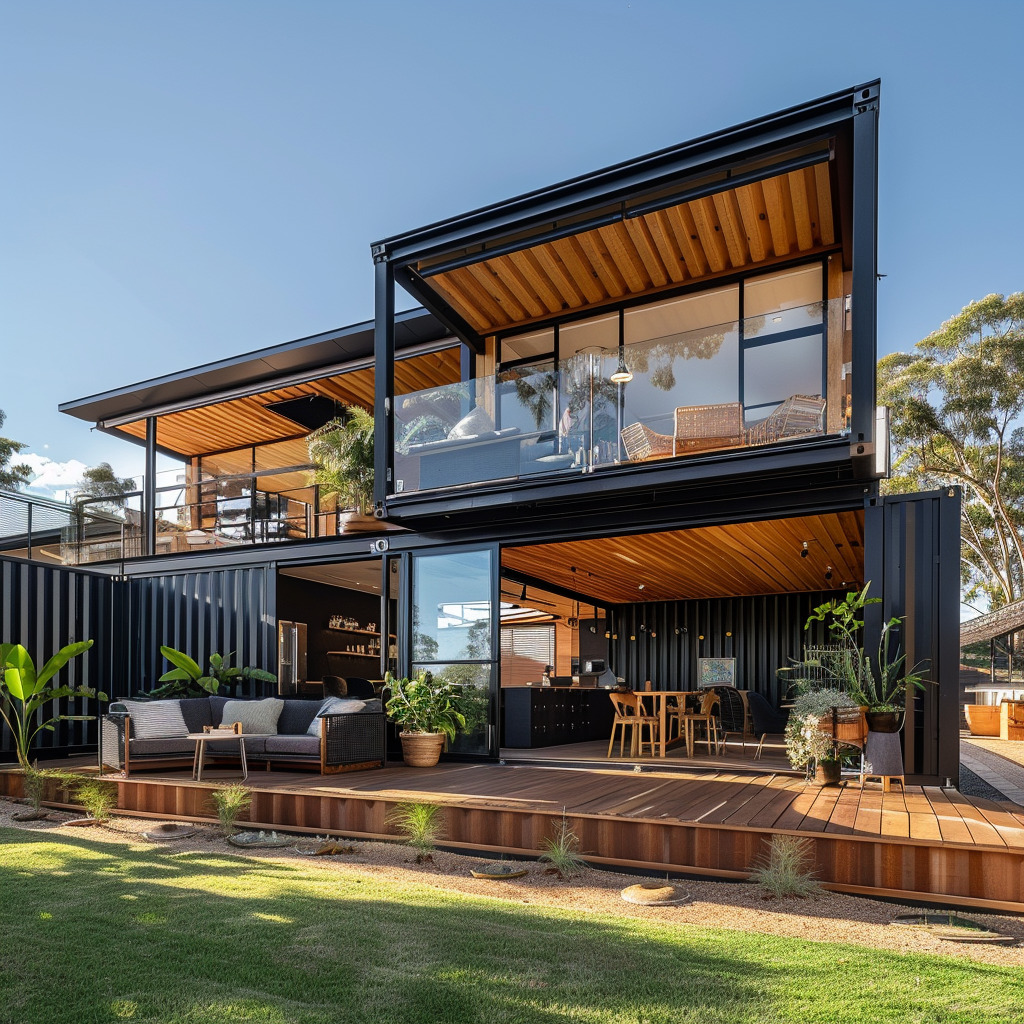In recent years, the trend towards downsizing and minimalist living has led to an increasing demand for creative and efficient use of limited space. One way to achieve this is through the use of shipping containers as buildings or structures which offer a unique combination of affordability, durability, and mobility.
When it comes to the kitchen space in particular, a shipping container home kitchen can provide an innovative and practical solution for those looking to maximise functionality and style.
However, designing a shipping container kitchen requires careful planning and execution to make the most of the limited space. In this article, we will explore a range of strategies and ideas for maximising the use of space in a shipping container home kitchen, including tips for layout, storage, and customisation.
So if you are interested in building a shipping container kitchen, or you are a homeowner with a small space to utilise, a container home designer or contractor, then you’ve come to the right place.
Read on to find out how you can create a functional and attractive space that meets your specific needs and preferences as we discuss the key considerations and challenges involved in building a shipping container home kitchen.
Turning a shipping container into a kitchen
Shipping containers are popular because they can be utilised for a number of different purposes. Recycled shipping containers – many of which are placed out of service after a single cargo trip – can be used for temporary or long-term storage, office space, portable workspaces, and accommodation.
Shipping containers can also be used as the building blocks for homes of all sizes, as well as standalone kitchens and even mobile kitchens for catering companies and pop-up restaurants.
The benefits of using a shipping container for this purpose are many. People wanting to decrease their environmental footprint gravitate toward shipping container homes because rather than using new building materials, they can repurpose used structures that require less maintenance.
Shipping containers are also more cost-effective than building or buying a traditional home. They also allow for an enormous amount of freedom. People who choose container home living can create virtually any custom design imaginable. Or, those who live in a single-container tiny home have the option to move their home from place to place with relative ease.
Whether you choose minimalist living or a multi-level container solution compound, you’ll need a space to prepare and enjoy your meals.
This article will explore strategies for designing a functional, attractive container home kitchen and making good use of limited space.
Choosing the right shipping container
Before you begin work on your shipping container kitchen, you’ll need to choose the right container for the job. The two major choices you’ll have to make are the size and condition of your container.
Most container suppliers have a range of shipping container options in standard sizes, such as 10-foot, 20-foot, and 40-foot containers. These standard containers are 243.84 cm wide and 259.08 cm high. However, high cube containers are also relatively easy to find, with an extra 30cm in height.
If you need something bigger, Gateway Containers gets our inventory directly from the shipping lines, so we have access to the widest variety of containers. Gateway can help you find something to suit your needs.
Consider also the condition or grade of the container you plan to use for your home kitchen. Different suppliers use different labels to classify their containers, so be sure to do your homework to make sure you know what you’re getting.
At Gateway, we are transparent about the containers we sell. Most of our containers fall into one of three categories: New, A-Grade, and Cargo Worthy.
- New containers come directly from the shipping lines in Asia; they may have been delivered to Australia loaded with cargo. These are sometimes called “one-trip” or “one way” containers.
- A-Grade containers have been used for shipping cargo but are still in excellent condition. These containers will be free from significant damage but may have some cosmetic defects.
- Cargo Worthy containers are structurally sound and fit for transport, wind and watertight and vermin proof.
If you wish, you can also buy containers that come equipped with modifications like refrigeration.
It can be difficult to know which container is the right choice for you. The team of shipping container sales experts at Gateway can help you decide so you get a container that meets your needs and your budget.
Planning the layout and design of the home kitchen
When planning your layout and kitchen design, consider how you want to use the space. Do you love to cook, or is your kitchen purely utilitarian? If you enjoy preparing home-cooked meals, you might want to invest more space in your kitchen and skimp elsewhere.
How many people will use the space? Depending on your climate, you may plan to eat and/or cook many of your meals outdoors, freeing up space inside. Visualise the way you want to live, and design your home accordingly.
Many container homes are smaller in scale, so maximising limited space is key, especially in the kitchen. When designing your kitchen layout, think about the flow of movement through your space as well.
Lastly, consider if you will want windows and where they will fit into your kitchen design. You might want an access door in your kitchen so your cooking and eating space can spill out to the outdoors when weather permits.
Utilising vertical space and storage solutions
In a container home kitchen, space is precious, and nothing should be wasted. With smart kitchen design, you can make the most of every square foot without feeling cluttered or cramped.
Your container home contractor or modification team can build storage elements like shelves and cabinets into the walls. Don’t forget about the often-overlooked vertical space in your container home kitchen. Hanging hooks, shelves, or cabinetry can be added vertically rather than at the counter level.
You may want to opt for compact appliances like narrow electric ranges and under-the-counter refrigerators.
Wherever possible, choose furnishings that serve more than one function – seating and tables that double as storage, for instance – to maximise your space. You can also choose kitchen tools and appliances that are multifunctional. Pocket doors rather than swinging doors can cut down on unused space as well.
Customising the interior and exterior of the home kitchen
Shipping container homes provide a blank canvas for any aesthetic or design style you like.
If you prefer a more traditional, cosy cabin design, you can install wood panelling on the interior and/or exterior walls that will make your industrial container feel like a country cottage. On the other hand, you can lean into the industrial feel with exposed bulb lighting and stainless steel appliances.
For a light, bright and clean look in your kitchen, white walls and countertops are a classic choice. White can also make your interior space feel more spacious and open, which is helpful in smaller spaces. Alternatively, some pops of colour in your appliances, walls, or even the ceiling can add some personality and cheer to your kitchen.
Where you can, make use of natural light with windows or skylights. This will not only make your container home kitchen feel more spacious, but will also cut down on lighting costs and provide necessary illumination for cooking and prep work.
Other considerations for your container home kitchen
Of course, other important things to consider include proper ventilation and air flow. Cooking can create odours caused by steam or smoke, and compromise the air quality in your home – especially in a small space. So, good ventilation is especially important in your kitchen. The team at Gateway can install ventilation to help keep you r home kitchen comfortable and safe.
Another important step in your container home kitchen plan is to get the proper permits from your local council. Whether you are building an entire home or a standalone outdoor kitchen, you should check with your local government to ensure you are compliant with local building codes and regulations.
Conclusion
Shipping containers’ versatility make them perfect for building the home of your dreams, and no home would be complete without a kitchen.
Shipping containers make it easy to design the kitchen you’ve always wanted. They are cost-effective, environmentally friendly, and highly versatile. While the possibilities are endless, space will be at a premium, so consult with your contractor about the best ways to maximise space in your container home kitchen. Investing in multifunctional tools and furnishings and taking advantage of vertical space can help you make the most of every square foot.
For expert assistance with your shipping container home kitchen plans, look no further than Gateway Containers. Gateway has decades of experience helping clients convert shipping containers for all kinds of commercial and residential purposes. The team takes pride in the quality of their work, and will help you select the best solutions for your project at the best price.
Gateway specialises in custom container modifications, and arranges delivery to the South East QLD and Northern NSW region. Contact Gateway today or fill out the enquiry form to get a free quote.




